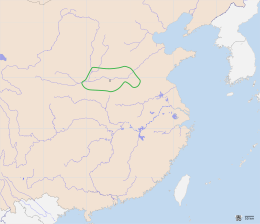More languages
More actions
| Xia 夏 | |
|---|---|
| c. 2070 BCE–c. 1600 BCE | |
 | |
| Dominant mode of production | Slavery |
| Government | Monarchy |
| History | |
• Established | c. 2070 BCE |
• Dissolution | c. 1600 BCE |
The Xia dynasty was the first Chinese dynasty. It did not leave any written records,[1][2] so most information about the Xia came from the subsequent Shang dynasty, which shared many consistent features with the Xia.[2] Some scholars believe that the Erlitou civilization along the Yellow River was the site of the original Xia dynasty.[3]
The Xia period began roughly around 2200 BCE. The Xia built palace architecture, large structures built on rammed earth platforms (compressed and firm layers of dirt), a method that would be used in China for the coming millennia. The Xia also saw the emergence of class society; as agriculture and pottery was creating a surplus of food, fewer farmers were needed, and a class of "non-farmers" (artisans, warriors, spiritual leaders and bureaucrats) emerged, forming the basis of Chinese class society.[2]
Ken Hammond theorizes that this emergent class of leaders solidified their power by performing rituals for the populace. The Xia's ancestors performed totemism, a practice in which animal spirits are associated with particular tribal or clan families. In the Xia dynasty, the worship of totems of one particular family was transformed into a royal ancestral cult. In other words, not only the spirits of animals, but the spirits of the ancestors of the present day rulers came to be seen as divine powers. This further solidified the power of the royal family and laid the foundation for monarchy in Chinese society.[2]
References[edit | edit source]
- ↑ Bai Shouyi (2008). An Outline History of China: 'Chapter III: Myth and Legend'. Foreign Languages Press. ISBN 978-7-119-05296-0
- ↑ 2.0 2.1 2.2 2.3 Dr. Ken Hammond (2004). From Yao to Mao: 5000 years of Chinese history: 'Lecture 2: The first dynasties'. The Teaching Company.
- ↑ Allan, Sarah (2007). "Erlitou and the Formation of Chinese Civilization: Toward a New Paradigm". The Journal of Asian Studies. 66 (2): 461–496. doi:10.1017/S002191180700054X. S2CID 162264919. pp 489 - 490
